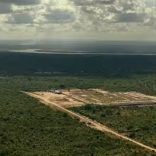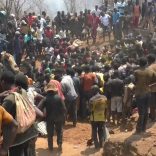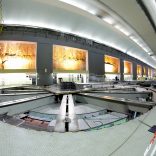TotalEnergies aiming to drill in South Africa next year, says executive
“Connecting the tourism and industrial sectors will help Inhambane develop”

O País / Daniel Chapo, Inhambane Governor
The recent investment conference in Inhambane has been discussing tourism and other sectors with a view to consolidating a strategic plan.
O Pais: In tourism, the major complaints heard have to do with sectors that are beyond the provincial government’s control. For example, there are complaints about the behaviour of the Traffic Police collecting revenue for the Treasury (although Inhambane accounts for about 60 percent of the national tourist market). How will these aspects be discussed at the conference so that a clear action plan to address these issues is put in place?
Daniel Chapo – The key objective of the conference is to bring together various viewpoints, various public and private sector players that directly or indirectly operate in tourism and can contribute ideas.
Recently, we were in Johannesburg, South Africa, and one of the aspects raised was the number of inspection stops that South African tourists experience after crossing the border from Ressano Garcia on their way to Inhambane. Since the end of 2016, we have had a lot of praise from tourist from South Africa and elsewhere because, before the start of the festive season, we recommended that our police be more educational than punitive, so in cases of speeding, for example, they would recommend slowing down.
Now we are working to make this behaviour permanent. Regarding revenues, most of the people who make reservations in our tourist resorts do so outside the country. But we are working with the Tax Authority to create a multisectoral team that can monitor incoming tourists and compare what tourism resorts declare as revenue during the year and the number of tourists they have received and across which borders they arrive,
OP- Another aspect that tour operators raise in Inhambane is that most tourists come with their own food and clothing, among other things, which does not create value in the local economy. Is that a tourist problem or a zonal problem, in that it is unable to provide quality products for tourists from the United States, Europe and South Africa, for example?
DC – The problem is on all sides. There are agreements with South Africa covering these things. The SADC is in the process of integration, with free movement of people and goods. But at the local level we also need to increase the capacity to supply goods in quantity and quality. That is why we have started building supermarkets in Inhambane. We just finished one in Massinga; we going to build another in Vilankulo, one in Maxixe and another two in Inhambane and Inharrime. The goal is to create a value chain, to get district producers to market and sell to supermarkets and to add quality to the products. This will allow us to be responsive in the future.
OP- Regarding infrastructure, previous governors and the current one (Daniel Chapo) point up the 500 km Mapinhane-Pafuri road as a crucial tourism project, and the route also serves Gaza province and South Africa. How do you intend to boost the construction of this road?
DC – The objective is to follow up on the excellent work done by the governors who have held office in Inhambane previously. Last year, we were in China and this road was one of the projects in our portfolio. Now we are in South Africa to see how we can develop this joint project, especially since the road comes to South Africa. Fortunately, we are in perfect harmony with South Africa. So there are many groups interested.
OP – Aside from being a dream project, is this road viable? And what would the elements of its viability be?
DC – There are many. First, Inhambane is one of the largest beach tourism areas in the Southern Africa. Bazaruto, Inhassoro and Vilankulo are benchmark references. And when we were in South Africa, most business people argued that it would be good to have a single package, so that tourists would come as inland tourists and then have a choice of beach tourism, and the closest in the region is in Inhambane. So, to boost tourism, in addition to creating infrastructure for access to sites, planning tourist areas, electricity, water and so on, a corridor that makes a fast land connection is necessary.
The second point is that one of the largest gas exploration projects, which has been going on for more than 15 years, is in Inhambane province and will now move to the second phase, which is gas liquefaction, and it is our intention to create an industrial zone in that region. So you can aggregate a city with this road and connect the tourist and industrial aspects. For the road to be viable, there must be alignment between the countries of the region, and this is happening.
OP – As you have said, this thinking fits within Inhambane’s 2011-2020 strategic plan, but it happens in a context where we have situations of discontinuity of governors and directors, who arrive, find projects and make new ones. Was it not your case?
DC – No, it wasn’t. We are continuing the implementation of this plan. Being half-way through the project implementation, we are conducting a mid-term evaluation. We have hired a team of consultants who will tell us how we are moving in relation to the strategic plan, and this will be presented at the investment conference. And the aim of this conference is to accelerate the implementation of the strategic plan so that, by the end, the goal can be achieved and another plan drawn up.
OP – What other major infrastructure projects are being showcased at the conference?
DC – Among the big projects are the the Inhambane-Maxixe bridge, the Lindela-Inhambane road, which has too many bend and needs widening, the Inhambane-Tofo Beach road and others. Ameliorating the amount and quality of electric power is already underway with the construction of a substation in Lindela. Also planned is the construction of a 400 megawatt gas-fired power plant in Temane and a Temane-Maputo transmission line. These projects also depend on the government’s endorsement.
OP- Inhambane is one of the poorest provinces in the country, with almost half of its population walking at least two kilometres to get water. What are the big challenges to solve the problems of food, health, education, poverty in general?
DC – Regarding health, we have started the construction of the provincial hospital in the city of Maxixe, which had been planned for the city of Inhambane, but we decided to build it in Maxixe, because the other one has not been full. We also plan to construct several other health centres. In relation to water, we have recently installed a system in Inharrime, and systems in Morrumbene and Homoine which will be inaugurated in July or August. The great challenge remains in rural areas. Regarding education, this year, we will build 84 classrooms throughout the province. In rural areas, we have asked all districts tto choose a locality which puts education closer to the population.
Inhambane Province Investment Conference
The Inhambane provincial government is holding an investment conference which ends today and was yesterday officially opened by Prime Minister Carlos Agostinho do Rosario, who arrived in the province on Wednesday afternoon.
Do Rosario talked about how the event would bring together national and foreign businesspeople. “The province conference will attract investment to the areas with the greatest potential, and also in infrastructure, tourism and fisheries. We want the province to advance in line with progress in the country generally,” he said.
One of the main objectives of the event is to attract investments in roads in order to facilitate the flow of agricultural production from the countryside to the city of Inhambane.
“We know that the province has produced a lot this year. Agricultural production will double, and we want to support this effort with infrastructure such as roads linking the whole country, with roads linking provincial capitals to districts. We want to promote the dynamism that the province is manifesting,” said the prime minister.
Do Rosario said he believed the country was showing signs of recovery, which must be consolidated through accelerated growth in the provinces.













Leave a Reply
Be the First to Comment!
You must be logged in to post a comment.
You must be logged in to post a comment.